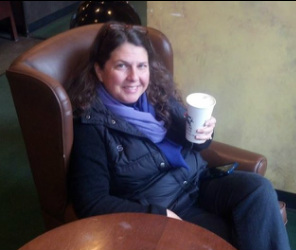In response to a homeschooling dad who worried that his kids were missing out because our homeschooling group didn't have "an official logo, seal, colors and mascot."
Regardless of what I say next, please note that I find your concern about your kids touching and typical of the homeschooling parent. We all want to be sure we haven't deprived our kids of anything with our choice to homeschool.
When I talk about homeschooling at work, or in social groups, or with family members, I am always careful to point out that homeschooling is not necessarily BETTER than school. You trade one set of experiences for a different set of experiences. While we could debate which of the schoolish experiences it would be fun to adapt to our situation (such as proms, clubs, government, choirs, athletics etc.) it's important to remember that we can't have all of the good stuff that goes with school and not go to school.
It may also be time to point out that while RAHA does have a logo and is compelled by its constitution to have monthly meetings, publish a newsletter, and stay on top of homeschooling political events, RAHA has been very careful to limit what the organization does and empower its members to do whatever they feel compelled to organize for their family. This has been oversimplified in the phrase: "RAHA doesn't do anything, RAHA families do EVERYTHING." What this means is that you can use the RAHA name to organize events if you find it helpful, you can use the newsletter to disseminate information, you can come to meetings to drum up support, but RAHA will not take ownership of much, and when they do it is a very slow and deliberate event.
You say that there is a "sense of isolation and extreme privacy inherent in homeschooling." That runs directly contrary to my experience. I don't know how long your family has been in RAHA, but perhaps you are recent members and your family is still discovering the many different ways to be active within the group. My family actually suffers from activity overload. There is no way we can see all of the people we want to see and do all of the things we want to do. See past issues of the newsletter for more info on how RAHA members get connected. As for privacy, I find that society at large feels that my family's educational and lifestyle choices are open for comment. What we do is right out there for all of the neighbors and relatives to see.
Now on to the issue of belonging...Yes, it is fun to feel like I belong. Where do I feel that? (Keep in mind that I am a painfully shy, rejection-fearing neurotic regardless of any appearances to the contrary, so we could ask Does Mary Joan ever feel like she belongs?) When I feel that sense of belonging it is usually at home with my family, when I am with my close friends (and after ten years in RAHA and forty years of life I have a good number of those), driving around Rochester feeling happy to be here, or when I am part of a group that openly excludes others and has chosen me. Did everybody read that last one? Read it again.
Yes, I have an adolescent streak that would delight in being part of an exclusive club that requires special clothes, hand signals, secret rites and rituals, mascots, songs, the whole clubby, my team's better than your team bit. I wore a varsity jacket in high school (that I earned, not my studly athlete boyfriend's), I went to to the prom, and (gasp) I was a cheerleader. I was part of National Honor Society and Varsity Club, both of which you had to get voted into. Were there fun things that were part of all that? Yes, but the whole notion of my group is better than your group, my team is better than your team encourages competitive behavior as well as creating (what I feel to be a false sense of) community.
I treasure that my children feel like they are part of a community, not a school, club or gang. It might be fun if someone made RAHA t-shirts, but beyond that I would use caution. When you get into mascots and colors, you're talking not only about broadcasting that you belong to something, but that others don't. I believe that many of us (me included) crave the sensation of being part of a group that is select and has chosen us, but how much of that comes from experiences that taught us we didn't belong, we didn't make the cut? It could be said that ALL families homeschool, after all.
I believe that our greatest challenge (and greatest payoff) as homeschooling parents is that we have to create our own community for our kids. We have to help them (because of logistics, interests, etc.) find their niche. A true niche doesn't need to be broadcast with cheers and jackets, it's something one feels inside of one's self when one pursues one's true nature.
But don't let what I've said stop you. As a family you have only your time and pocketbook and energy as the limits, and there may be many other homeschooling families out there who have been hoping for a similar opportunity. Have fun!


 RSS Feed
RSS Feed